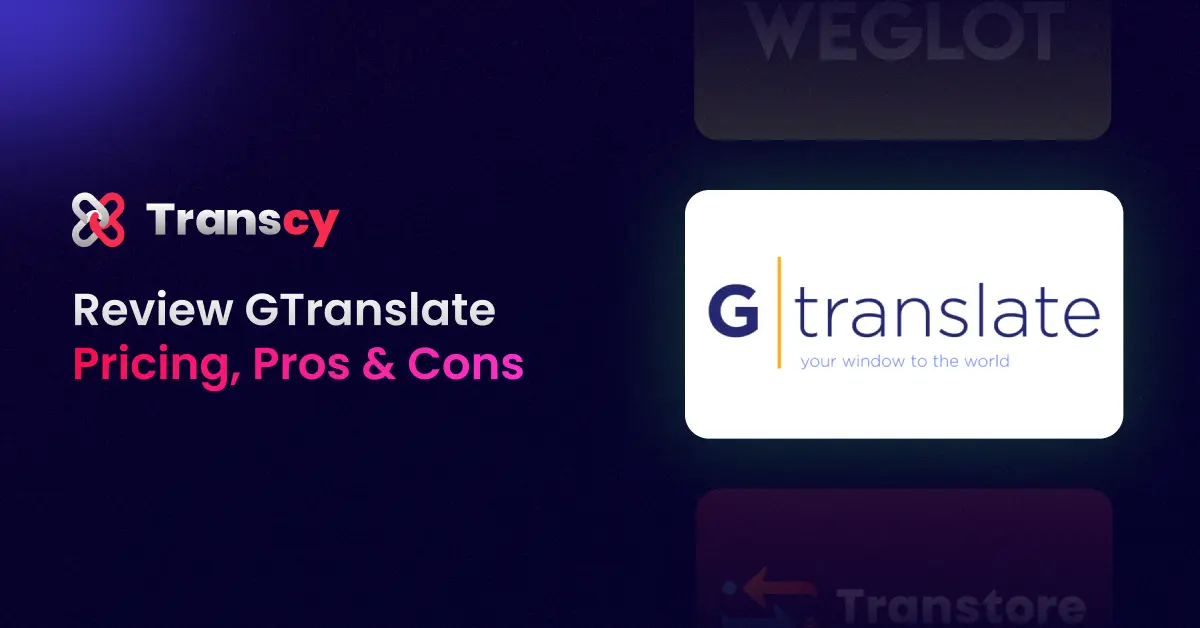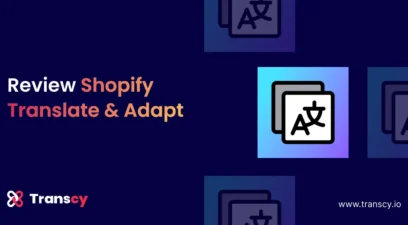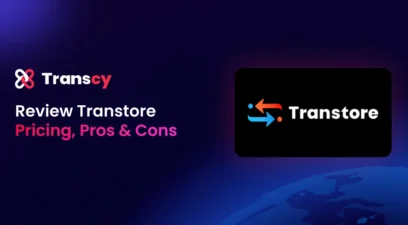| 💡 TL;DR GTranslate is a website translation tool for platforms like Shopify and WordPress. Known for its ease of use, GTranslate helps websites become multilingual using Google Translate’s automatic translation capabilities. | |
Pros
| Cons
|
Highlight features
| Pricing
|
Looking to translate your Shopify store quickly and reach more global customers? In this GTranslate review, we’ll dive into what the app actually delivers, from setup and translation quality to SEO performance and customization.
Whether you’re launching in new markets or just exploring multilingual support, this hands-on analysis will help you decide if GTranslate fits your demand and budget or not.
What is GTranslate?
GTranslate is a Shopify app that automatically translates your store content into multiple languages using machine translation. In essence, it acts as a “plug-and-play” multilingual solution, leveraging engines like Google Translate to instantly convert your site for international audiences.
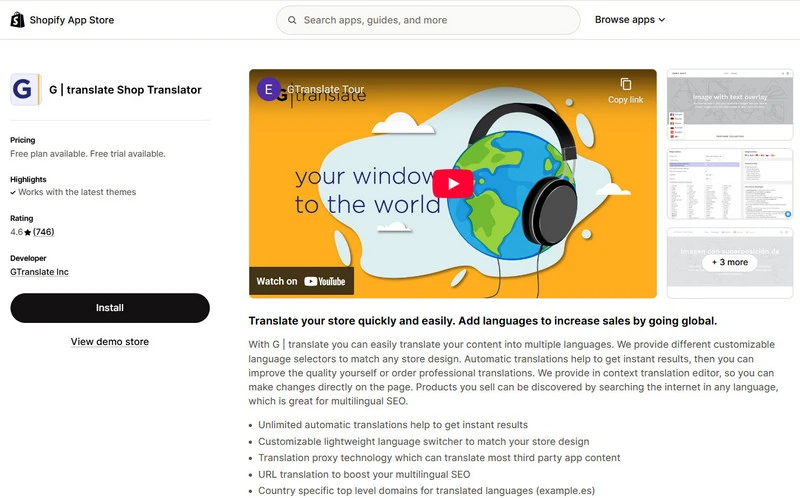
Here are a few top features GTranslate offers:
- Automatic machine translation of your store’s content into over 100 languages.
- Customizable language selector widget, allowing customers to switch languages via a floating selector or menu integration
- Auto-detection of visitor language with optional automatic redirection.
- Manual translation edits for fine-tuning translations (available on paid plans)
- SEO localization: GTranslate can use sub-domains or sub-directories for each language (on certain plans) to serve translated pages, which is intended to support multilingual SEO. For example, you might have fr.yourstore.com for French or paths like yourstore.com/fr/ for translated content.
- Third-party app content translation: The app is capable of translating text from many third-party Shopify apps (reviews, page builders, etc.).
A comprehensive review of GTranslate
We tested GTranslate on a demo store to see how it performs in practice, and we found that it can indeed render your entire site in a new language within minutes of installation. This has made it a popular choice among Shopify merchants looking to “go global” quickly.
The app launched in 2017 and currently holds an average rating of 4.6 out of 5 on the Shopify App Store (based on 700+ reviews).
However, outside the Shopify ecosystem, the feedback is more mixed (for example, a Trustpilot score around 3/5), which hints at some deeper issues and differences in user expectations that we’ll explore in this review.
1. Pricing
| ⭐ Our rating: 4.5 out of 5.0 Overall, GTranslate has relatively high value for money. The only deduction is that the free plan is limited in terms of translation quality and SEO localization functionalities. |
The app offers a free plan and multiple paid tiers, ranging from $9.99 to $29.99/month.
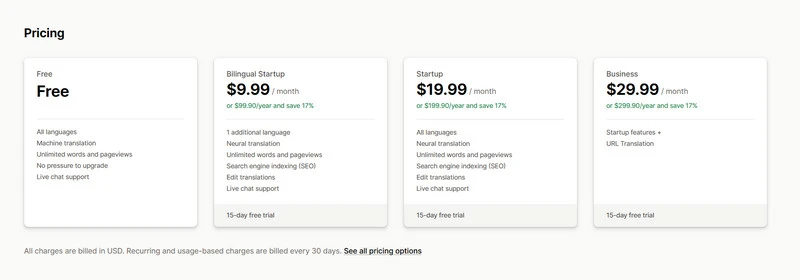
The free forever plan offers unlimited machine translation for all languages, with no cap on words or page views. However, the plan lacks some crucial features: you cannot manually edit translations or have those translated pages indexed by search engines on the free version.
So if you want to unlock more translation capabilities, you could choose to try one of the app’s paid plans, including:
- The entry-level paid tier (called “Bilingual” or similar) starts at $9.99/month and allows you to add one additional language, offering benefits such as neural translation quality, the ability to edit translations, and search engine indexing (SEO) for that language.
- The next tier ( $19.99/month) covers all languages with editing and SEO indexing, which we found to be a fair value if you genuinely need a multilingual store with dozens of languages.
- The highest tier ($29.99/month) introduces advanced features like URL translation (serving each language on a separate domain or subdomain) and possibly higher support priority.
Compared to other translation apps, GTranslate’s pricing is on the affordable side. For example, some competitors charge based on word count or number of languages and can become far more expensive as you grow, whereas GTranslate’s “unlimited words” policy on all plans is reassuring.
2. Number of language support
| ⭐ Our rating: 5.0 out of 5.0 GTranslate’s comprehensive language support and the ability to use all languages give it a perfect score in this category. |
When it comes to language coverage, GTranslate excels. The app can translate content into over 100 languages, essentially every language supported by Google Translate (and even some by Bing).
In our hands-on use, we added a mix of common and less common languages (English to Spanish, French, German, as well as Japanese, Arabic, and even Welsh for testing) – GTranslate handled them all without any manual setup beyond selecting the language from a list. This broad support earned a full score from us, as it ensures that merchants can reach audiences in almost any locale they desire.
A notable aspect is that the free plan imposes no limit on the number of languages you can enable. We were pleasantly surprised that even on the free tier, we could offer a dozen languages on our store (the only trade-off being the aforementioned lack of editing/SEO for those).
This is a big plus given the fact that many competing apps have stricter caps on languages in lower tiers (for example, some limit free usage to 1–2 languages).
3. Translation quality
| ⭐ Our rating: 4.0 out of 5.0 GTranslate’s reliance on top MT engines means it’s as good as it gets without human involvement. The one-point deduction reflects that it’s still machine translation – businesses with very brand-sensitive content or complex copy will likely need to review and tweak some outputs. |
Translation quality is often the make-or-break factor for these apps. In our experience, GTranslate’s translation quality is decent, comparable to what you’d expect from Google Translate, which powers it.
For many languages and general eCommerce content (such as product descriptions and homepage text), the automatic translations were grammatically correct and conveyed the basic meaning effectively.
However, it’s not flawless. In a few cases, especially with specialized terms or colloquial expressions, the translation was literal or slightly off-target. For example, a tagline containing a pun did not carry over its double meaning in French – unsurprisingly, as machine translation often struggles with context and wordplay.
We also observed that text in all-caps or containing special characters sometimes didn’t translate at all. This aligns with a G2 review we saw where a user mentioned, “whenever text is written under any special character or a quote in the local language, then GTranslate sometimes gets stuck to translate it.”
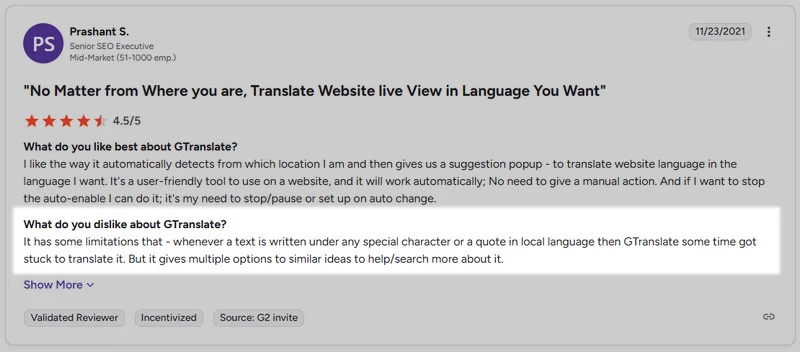
4. Customization of your translations
| ⭐ Our rating: 4.2 out of 5.0 We had a positive experience controlling and tailoring our translations, especially with the premium features. The deduction is primarily because on the free tier you have virtually no customization (you’re at the mercy of raw machine output). |
By “customization,” we refer to how much control you have over your translated content and the translation process. GTranslate provides a few avenues for customization, and we tested each:
Manual edits
As mentioned, you can manually adjust translations through an intuitive in-context editor (available on paid plans). This WYSIWYG style editing made it easy to fine-tune wording and ensure the tone matches our brand voice. The process felt smooth and required no technical skills. The only caveat is that this ability is locked behind the subscription, so free users cannot customize translations at all (hence our not-quite-perfect score here).
Exclude or skip translations
We discovered that GTranslate’s settings allow you to skip translating certain elements if needed. For instance, if you have a brand name or a term you want to keep in English across all languages, you can add it to a skip list. We tested this by excluding a coined term from translation, and indeed, the app left that term untouched in all languages.
5. Auto-translation capabilities
| ⭐ Our rating: 4.5 out of 5.0 GTranslate largely delivers on “automation” – you set it up once and it keeps your site translated with minimal ongoing effort. The slight half-point drop is due to the occasional hiccup with dynamic content translation timing, but this was a rare issue. |
We were particularly impressed by how GTranslate handled different types of content automatically. It translated product titles, descriptions, page content, navigation menus, and even text from Shopify-native areas like the checkout and system notifications.
Moreover, as noted earlier, it could translate third-party app content on the fly due to its proxy approach. For example, our store had a reviews widget (from a separate app) and the review texts were machine-translated when viewing the site in French.
That said, it wasn’t entirely flawless, though. We encountered a minor issue where some content from an app (a pop-up widget) did not translate on the first page load. Specifically, it initially displayed in the original language and only translated after a couple of seconds or on the next page.
This corresponds with a few user reports about “occasional delays with translating additional apps or widgets.” In our case, it wasn’t a critical problem; the content did translate eventually, but there was a slight lag.
6. SEO localization
| ⭐ Our rating: 3.5 out of 5.0 GTranslate can boost your multilingual SEO, but it requires using the paid features carefully and understanding the proxy setup. |
SEO localization is a critical aspect for merchants who want their translated pages to rank on search engines. This is an area where GTranslate’s unique approach has both strengths and weaknesses, which we scrutinized in our testing.
On the plus side, GTranslate does provide mechanisms for SEO-friendly translations on its paid plans. Specifically, starting from the $9.99/month plan, you can enable search engine indexing for translated content.
What this means is that GTranslate will serve the translated versions of your site in a way that search engines (like Google) can crawl and index them. This is a big advantage because it can potentially get your site to appear in search results in different languages, attracting organic traffic from international markets.
However, there are some limitations as well. First, the free plan offers no SEO support at all. This means that it’s only for human visitors switching languages manually. So, anyone serious about multilingual SEO will need a paid plan.
Another limitation is that while GTranslate will translate your page content for SEO purposes, it may not translate elements such as meta tags (title, description) or alt text for images.
In our tests, the page <title> for translated pages was translated by GTranslate’s proxy (e.g., “Shop – Example” became “Boutique – Exemple” in French on the rendered page). So it appears the proxy does handle titles.
Meta descriptions, however, we had mixed observations: one page’s meta description remained in English in the HTML source of the translated page. This suggests that some metadata might not be translated unless it’s visible on the page.
Pros and cons of GTranslate
Here’s a breakdown of the key strengths and drawbacks we observed during our testing.
Pros of GTranslate
- Fast and simple setup: GTranslate can be installed and configured in minutes. It doesn’t require coding skills, making it a great fit for beginners or merchants without technical resources.
- Broad language coverage: With support for over 100 languages, the app covers nearly every major market globally—ideal for merchants wanting to reach diverse audiences.
- Automatic full-store translation: Once enabled, GTranslate instantly translates all visible content across your store, including product descriptions, menus, and even some third-party app elements.
- Smart language detection: The app can auto-detect a visitor’s language and prompt them with the appropriate version of your site, helping streamline the shopping experience.
- Customizable language switcher: The built-in selector can be styled and positioned to fit your store’s branding, giving you control over the UI without needing to code.
- Responsive live chat support: In our testing, support was quick to respond and helpful in resolving setup issues. Many users echo this in reviews, though experiences can vary.
- Competitive pricing: With generous free and affordable paid plans offering unlimited translations, GTranslate provides strong value, especially compared to per-word pricing models.
Cons of GTranslate
- SEO limitations on free plan: The free version does not index translated pages, which means no SEO benefit. Even on paid plans, improper setup can lead to indexing or hreflang issues.
- Mixed support experiences: While our support experience was positive, some users report inconsistent service quality—especially when dealing with complex issues.
- Translation quality varies: Machine translations are good for general content but may produce awkward or inaccurate results in more nuanced or brand-sensitive text.
- Occasional glitches with dynamic content: Some third-party app content or pop-ups may not translate properly without extra setup, causing parts of your site to remain untranslated.
- Uninstalling can be tricky: If not properly removed, GTranslate’s setup (especially with SEO subdomains) can leave broken links or payment warnings on previous language URLs.
- Free plan lacks key features: Manual editing, SEO indexing, and advanced customization are only available on paid plans—limiting the usefulness of the free version for long-term use.
Who should and should not use GTranslate?
Who should use GTranslate?
GTranslate is best suited for merchants who need a quick, hassle-free way to reach a global audience, especially those on a limited budget or without in-house translation resources.
If you identify with any of the following, GTranslate could be a great choice:
- Stores seeking fast international expansion
- Those who prefer automation over manual work
- Budget-conscious businesses
- Merchants who are okay with “good enough” initial translations
- Webmasters without coding expertise
Who shouldn’t use GTranslate?
While GTranslate is powerful, it isn’t the perfect fit for everyone.
You might want to consider alternatives if you fall into these categories:
- Brands requiring high-precision or creative translations
- SEO-driven merchants with complex SEO strategies
- Those needing multi-store or localized store control
- Merchants who require translation of non-text elements
- Anyone uncomfortable with external dependencies
Is there any alternative to GTranslate?
GTranslate is a solid translation app for Shopify. It’s fast, easy to implement, and capable of handling over 100 languages.
However, its limitations in SEO indexing, customization, and long-term flexibility lead many merchants to seek out more scalable and Shopify-native alternatives.
One of the most recommended options is Transcy, a Shopify translation app that addresses several of GTranslate’s core limitations while offering additional localization features like currency conversion and image translation.
Below is a quick comparison of the two:
| Feature / Capability | GTranslate | Transcy |
| Installation & Setup | Extremely fast setup with auto-translation on install | Simple setup; slightly longer due to Shopify-native integration |
| Translation Method | Proxy-based; does not store translations in Shopify | Stores translations within Shopify’s system |
| Manual Editing | Available on paid plans only | Available even on free tier (limited), more flexible editing on higher plans |
| SEO Optimization | Basic SEO via subdomain/subfolder setup; some indexing risks | Full integration with Shopify’s SEO structure; translates meta tags |
| Supported Languages | 100+ (via Google Translate) | 100+ (via Google & Microsoft engines) |
| Currency Converter | Not included | Built-in converter for 160+ currencies |
| Image & Media Translation | Not supported | Supported (swap images per language) |
| Free Plan Limitations | No editing or SEO features | Includes basic editing, SEO meta, and currency features |
| Customer Support | Mixed reviews; generally responsive but inconsistent | Widely praised; fast and highly rated |
Conclusion
GTranslate is an efficient solution for quickly making a Shopify store multilingual. It delivers speed, breadth of language coverage, and ease of setup. However, limitations around SEO, translation accuracy, and content ownership may become obstacles as your business grows.
Hence, if long-term localization, tighter integration with Shopify, and greater flexibility are priorities, a more robust tool like Transcy may be the better fit.
Frequently asked questions
What is the most reliable translation app?
There’s no one-size-fits-all answer, but several apps consistently rank high for reliability.
Weglot is known for premium features and excellent SEO support, while Transcy is often praised for its Shopify-native integration and extensive localization tools.
Meanwhile, GTranslate remains a strong contender for merchants needing fast, broad translation without high costs
Is GTranslate the same as Google Translate?
Not exactly. GTranslate uses Google Translate’s engine (and optionally Microsoft’s) to power its machine translations, but it is a separate product.
In other words, it’s a website localization platform that leverages Google Translate as the backend translation provider—but offers a lot more around it.
Table of Contents

